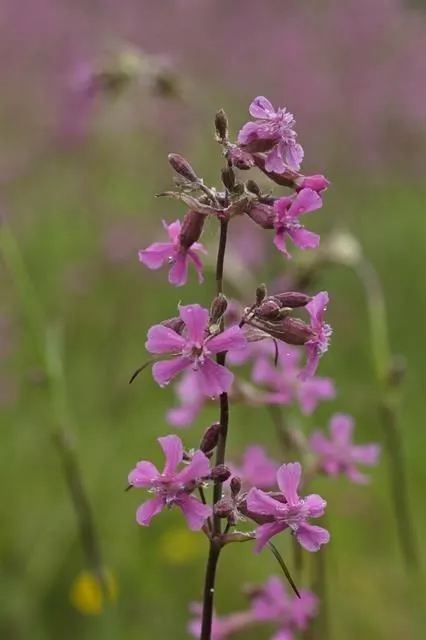
Author: Jess.
Bibliography: Unknown
Year: Unknown
Status: accepted
Rank: species
Genus: Silene
Vegetable: Unknown
Observations: Unknown
Clammy campion, known scientifically as Silene viscaria, is a striking and resilient plant species that belongs to the Caryophyllaceae family. This captivating plant, often found gracing meadows and open woodlands, is celebrated for its vibrant blossoms and sticky stems, which give it the common name “clammy.”
Silene viscaria thrives in a range of environments, from nutrient-poor soils to more fertile grounds, demonstrating its adaptability and hardiness. The plant typically forms a basal rosette of narrow, lance-shaped leaves that can capture the eye with their lush, green hue. As the plant matures, it sends up tall, slender stems adorned with numerous flower buds.
The blooms of Clammy campion are a true spectacle. They usually appear in late spring to early summer, presenting clusters of vivid pink or occasionally white flowers. Each flower flaunts five notched petals, creating a charming star-like appearance. The sticky, clammy nature of the stems and calyx is a unique trait of this species, attributed to glandular hairs that help deter herbivores and reduce water loss, ensuring the plant’s survival in various conditions.
Silene viscaria is not only recognized for its aesthetic appeal but also plays a role in supporting biodiversity. Its flowers attract an array of pollinators, including bees and butterflies, which are drawn to the rich nectar and pollen. This interaction underscores the plant’s ecological importance in maintaining healthy ecosystems.
Though commonly referred to as Clammy campion, it is equally known by other names, such as Viscid catchfly or Sticky catchfly, alluding to its distinctive adhesive qualities. It stands as a testament to nature’s ingenuity in design and function, making it a fascinating subject for botanists and plant enthusiasts alike.
Regarding its cultivation, Clammy campion is relatively low-maintenance. It prefers sunny locations but can tolerate partial shade. Gardeners value it not only for its beauty but also for its ability to thrive in challenging conditions where other plants might falter.
While the full range of its uses and historical significance remains to be thoroughly documented, Silene viscaria continues to captivate those who encounter it, from casual observers to dedicated horticulturists. Its resilience and vibrant flowers make it a worthy addition to gardens and natural landscapes, offering both visual delight and ecological benefits.
En: Clammy campion, Sticky Catchfly, Red Catchfly
Bg: Лепило
Nl: Rode pekanjer
Fi: Mäkitervakko
Gd: Coirean Leantalach
Cy: Gludiog Coch, Lluglys Coch, Lluglys Gludiog
Taken Jun 4, 2020 by Danmer (cc-by-sa)
Taken May 22, 2022 by Ecaterina Temnicova (cc-by-sa)
Taken Jun 26, 2022 by Villu Serv (cc-by-sa)
Taken Jan 1, 1900 by EOL − Encyclopedia of Life (cc-by-nc)
Taken May 29, 2005 by Alain Lagrave (cc-by-sa)
Taken May 14, 2022 by Ana C (cc-by-sa)
Taken Jun 22, 2021 by Brychta Josef (cc-by-sa)
Taken May 29, 2019 by Saul Baga (cc-by-sa)
Taken Jun 4, 2021 by Katalin Szitar (cc-by-sa)
Taken May 15, 2022 by Fabrice Rubio (cc-by-sa)
Taken May 25, 2020 by Richmond Noe (cc-by-sa)
Taken May 15, 2020 by barci Petr (cc-by-sa)
Taken Jul 2, 2022 by Blue Bottle (cc-by-sa)
Taken May 15, 2022 by Fabrice Rubio (cc-by-sa)
Taken Jun 17, 2020 by Анатолий (cc-by-sa)
Taken Jun 23, 2019 by Vuk Bojović (cc-by-sa)
Taken Jun 22, 2021 by Brychta Josef (cc-by-sa)
Family: Myrtaceae Author: (F.Muell.) K.D.Hill & L.A.S.Johnson Bibliography: Telopea 6: 402 (1995) Year: 1995 Status:…
Family: Rubiaceae Author: Pierre ex A.Froehner Bibliography: Notizbl. Bot. Gart. Berlin-Dahlem 1: 237 (1897) Year:…
Family: Sapindaceae Author: Koidz. Bibliography: J. Coll. Sci. Imp. Univ. Tokyo 32(1): 38 (1911) Year:…
Family: Asteraceae Author: A.Gray Bibliography: Pacif. Railr. Rep.: 107 (1857) Year: 1857 Status: accepted Rank:…
Family: Fabaceae Author: Medik. Bibliography: Vorles. Churpfälz. Phys.-Ökon. Ges. 2: 398 (1787) Year: 1787 Status:…
Family: Aspleniaceae Author: (Cav.) Alston Bibliography: Bull. Misc. Inform. Kew 1932: 309 (1932) Year: 1932…